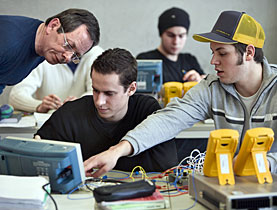Trainees put a stamp on their post office

As part of its vocational training scheme, Swiss Post is running eight post offices which are managed by a team of apprentices.
To coincide with an annual apprenticeship conference of representatives from the federal and cantonal authorities and labour organisations, swissinfo.ch visited one such post office in the town of Biel.
It is a real challenge for the 17 to 19-year-old retail apprentices. They carry out all the tasks, organise and run the office all by themselves. But it was also a big change for their coaches, all former post office workers.
“It is not up to me to run the office any more, to distribute work and tell the apprentices what to do,” says Claudia Jenny, one of two coaches who advises the team.
An apprentice should, instead, first turn to the head of the ten-strong trainee group – a rotating position taken by the older members for two months at a time.
The idea behind this special training programme – launched by Swiss Post two years ago on a trial basis – is to encourage apprentices to solve problems independently.
“We do not provide them with solutions. We try to help them by asking them questions and pointing out different possibilities,” Jenny says.
This helps the young people learn to tackle issues step by step and, in the end, take decisions quickly.
Jenny says it wasn’t always easy for her to let the apprentices try things out their own way. But values such as autonomy and responsibility are “sacred.”
Motivation
Running a post branch is not as simple as it might seem. Awaiting the trainees are a multitude of tasks both at the counter and in the back office: customers mail letters and parcels, pay bills, withdraw money, open accounts, subscribe to a telephone service, buy a telephone card or a ticket to a sport or cultural event…
At the same time the office has to make sure that it has enough cash, that the money transporter comes at the right time and that that the automatic teller does not run dry.
In addition, work plans have to be drawn up which take into account the apprentices’ school days – part of Switzerland’s renowned dual vocational training system.
The wide range of tasks is a motivation for 19-year-old Stefanie Beyeler. She has just taken over the role of head of team and she is not in the least scared by it.
“It’s an unique opportunity. It means having a lot of responsibility, more independence and that you can better understand how everything works,” she says.
Bilingual
The office in Biel-Mett is one of eight across Switzerland managed by apprentices. What makes it even more special is that it is in on a language border. Hence apprentices have to be able to serve customers in German as well as in French.
For Nicole Hofer, a native German speaker, this is not an additional difficulty, quite the contrary. “It’s an asset,” she says.
Her colleagues couldn’t agree more. “I might not become perfectly bilingual, but I’m sure I’ll improve my German. This will certainly be useful in the future, regardless of what I’m going to do after my apprenticeship,” says Justine Glatz.
“It is a launching pad for my professional career,” she adds.
Close team
The ten trainees come from different regions of Switzerland where they spent the first years of their apprenticeships.
They did not know each other, but soon became a real team which works together closely and with enthusiasm. They seem to live up to the slogan they coined for last August’s launch: “the new generation full of energy at your service”.
For an observer it seems nothing can stop them, not even the sales’ targets set by the headquarters for a broad range of products.
Both the apprentices and coach are confident that the team will give its best and reach those goals – to the letter.
Students in apprenticeships are normally hired and employed/trained by a company, while spending one-two days a week in vocational college. The mix of school and practical training is claimed to be one of the most important advantages of this dual system.
Students have a choice of about 300 recognised apprenticeship categories. Apprentices who pass the final exam at the end of their basic training are awarded a federal diploma which is recognised throughout the country.
Generally, the programmes followed (and the grades obtained) on lower secondary level serve as school selection criteria.
The meeting of representatives from the federal and cantonal authorities as well as employers and trade unions decided to boost diplomas for higher vocational training.
The aim is make such qualifications better known and to put them in line with similar European diplomas.
Last year about 28,000 diplomas for further vocational training were issued which qualify for senior positions.
The conference in Biel, attended by Economics Minister Doris Leuthard, stressed that the dual vocational training system – practical training combined with school – is key for Switzerland’s economy.
Two out of three people leaving school in Switzerland do apprenticeships.
About 83,000 of the total of 90,000 trainee positions were taken last August.
(adapted from Italian by Urs Geiser)

In compliance with the JTI standards
More: SWI swissinfo.ch certified by the Journalism Trust Initiative














You can find an overview of ongoing debates with our journalists here . Please join us!
If you want to start a conversation about a topic raised in this article or want to report factual errors, email us at english@swissinfo.ch.